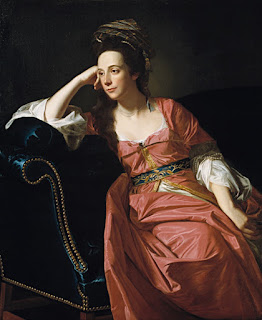The war continued and Gage worked his way up the ranks. Within two years he was granted permission to raise his own regiment. One of Colonel Gage’s officers in the unit was Stephen Kemble, who became Gage’s brother-in-law with the December 1758 wedding. Colonel and Mrs. Gage soon began a family and before the war’s end Gage rose to become a major general. When peace came in 1763 Thomas Gage was named Commander-in-Chief, North America and kept his headquarters in New York City. This was fortunate for Margaret, whose friends and family were largely concentrated in colonial New York and New Jersey. Overall it was a good period for the Gages and their growing family. Thomas Gage did well for himself, acquiring sizable land holdings in New York State, British Canada, and the West Indies. In the early 1770s Margaret sat for this striking John Singleton Copley portrait, considered by many art critics to be one of his finest works. The British had vanquished the French in North America but it was a pyrrhic victory as tensions with the American colonists accelerated over the following decade.After the Boston Tea Party George III appointed Gage colonial governor of Massachusetts. Still also commander-in-chief, it was Gage who would have to quell further unrest after the passage of the Coercive Acts. The task proved impossible and things came to a head at Lexington and Concord in April 1775.
There are some scholars who believe that Margaret Kemble Gage was a “mole” or “spy” for the Sons of Liberty and that it was she who tipped the Patriots off about her husband’s plan to seize the arsenal in Concord. There is no solid evidence to prove this however and a definitive answer will likely never be known. In a related note, some speculate that the Shot Heard Round the World—and Margaret Gage’s alleged role in tipping off the Patriots—cooled Thomas and Margaret’s marriage. No one can ever know what takes place within another couple’s union, but we do know that of their eleven children two were born well after the start of the American Revolution. What is clear is that the Siege of Boston damaged Gage’s political and military career. Following the Battle of Bunker Hill Gage placed General William Howe in charge of putting down the colonists. The former commander moved to London with his wife and was officially relieved of his duties shortly thereafter.
Back in New Jersey Peter Kemble remained a staunch Loyalist. Mr. Kemble had amassed a substantial estate in Morristown, New Jersey by the mid-eighteenth century. When General Washington searched for winter quarters in late November 1779 he looked to Morristown and chose a location that included part of the Kemble property. Washington and his men stayed until June 1780. The following winter of 1780-81 General Anthony Wayne headquartered in the Kemble House. It was likely due to George Washington’s affection that the Kembles were never harmed during the war. This is quite marked because several of Kemble’s sons, including Stephen, also remained loyal to King George III. The family was fortunate too after the war: unlike many Loyalists they were not stripped of their holdings and property. Peter Kemble died in 1789 and is interred in the family burial site on what was once his Morristown estate. His daughter, Margaret Kemble Gage, never saw New Jersey or America again. General Thomas Gage died in 1787. Mrs. Gage passed away in 1824 and was laid to rest beside her husband in St. Peter's Churchyard in East Sussex, England.
Written by Keith Muchowski, Morristown NHP volunteer.



No comments:
Post a Comment